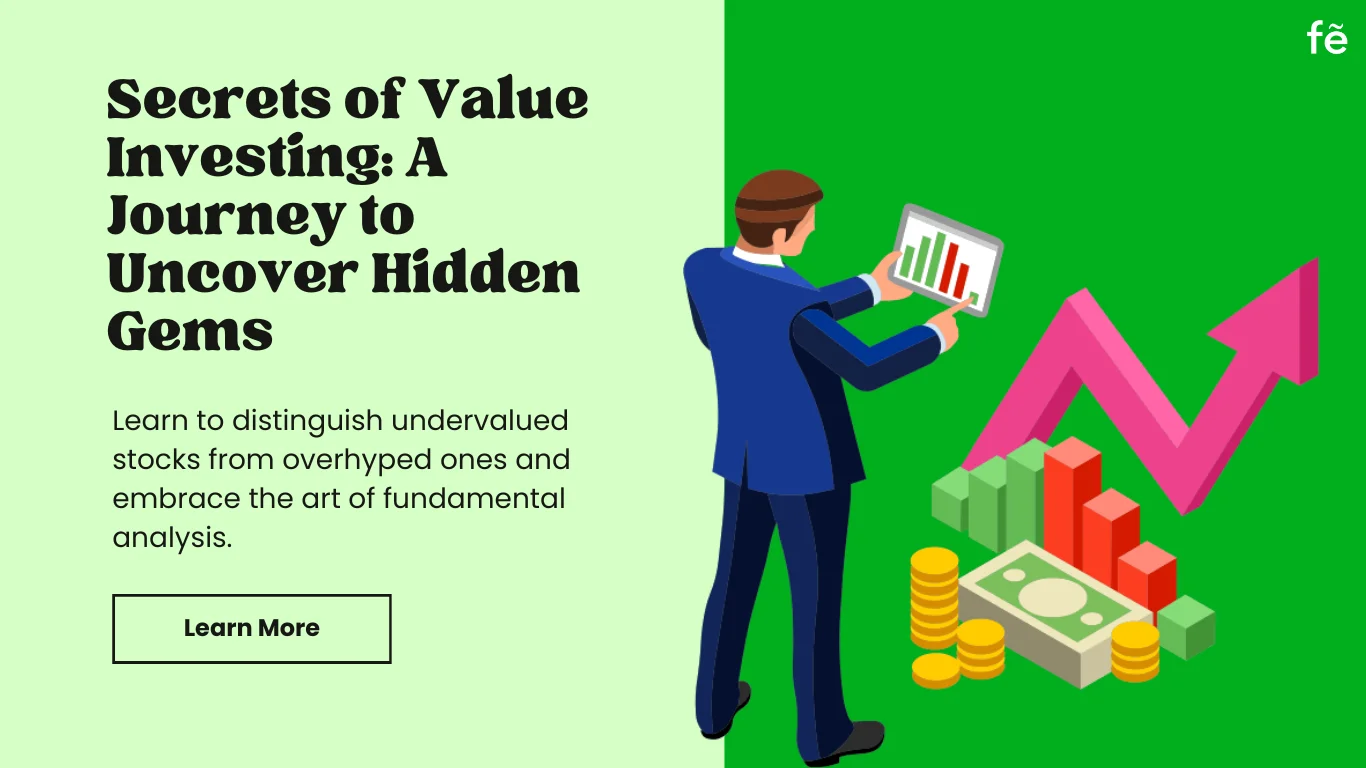
Do you ever feel overwhelmed by the endless stream of financial news, market speculations, and fads that swirl around the stock market? Fear not!
Let’s learn about value investing, where the stock market transforms into a treasure trove of hidden gems waiting to be discovered. In this journey, we shall embark together on a quest to master the art of value investing—a path with opportunities for those with a keen eye and audacious spirit.
Imagine the stock market as a vast landscape filled with shimmering jewels buried beneath the surface. These hidden gems represent companies with immense potential and intrinsic value, waiting for savvy investors to unearth their brilliance. In this blog, we know some timeless and proven approaches to cut through the market noise and unlock the secrets of value investing.
Our purpose is to reveal the essence of value investing, guiding you through the principles, metrics, and strategies that form the foundation for the value investor. We will explore the art of fundamental analysis, learn to distinguish undervalued stocks from overhyped ones and understand the psychological aspects of successful investing.
Understanding Value Investing

Value investing is kin to being a discerning art collector, seeking out underappreciated masterpieces that the market has overlooked. You have to buy undervalued stocks, like a bargain hunter searching for discounted treasures in a sea of inflated prices. By focusing on a company's intrinsic value rather than the fluctuating market sentiment, you become a master appraiser of true worth.
The cornerstone of value investing is the margin of safety, acting as both a shield and a ladder for investors. It is the parachute that softens the fall if a stock's price takes an unexpected decline and the stepping stones that lead you safely through the unpredictable terrain of the market.
Key Metrics and Ratios: Unleashing the Tools of the Trade
Value investors employ key metrics and ratios to reveal the true essence of a company's potential. The price-to-earnings (P/E) ratio is a spotlight that illuminates a stock's valuation, while the price-to-book (P/B) ratio peels back the cover to expose the relationship between market price and book value.
Also, you have to pay attention to dividend yield, savoring the sweet rewards of consistent payouts. To gauge a company's financial health, the debt-to-equity ratio acts as a balancing scale, evaluating the risks and rewards of leverage.
Distinguishing Value Investing: Standing Out in the Crowd
Amidst the hustle and bustle of the stock market, value investing stands out as an oasis of wisdom and logic. It contrasts with the frenzy of day trading and the allure of get-rich-quick schemes. Value investors are not gamblers; they are skillful artisans in the pursuit of long-term wealth.
By embracing patience, discipline, and a contrarian mindset, you can also dance to your own rhythm, detached from the herd mentality.
Researching Hidden Gems: The Art of Prospecting

Step-1: Identifying Promising Sectors
Like explorers seeking out uncharted territories, scan the market for promising sectors and industries. As an intelligent investor, find companies with strong economic moats, built to withstand the onslaught of competition, and competitive advantages that set them apart from their peers.
Value investors possess the visionary gaze of a seer, identifying long-term growth prospects that others overlook. They plant seeds of investments in fertile soil, knowing that with time and patience, their portfolio will flourish into a thriving garden of wealth.
Step-2: Scanning for Undervalued Stocks
Like Value investors, you have to employ screening techniques to sift through the market's vast expanse. Analyze financial statements like detectives scrutinizing evidence, searching for clues of undervaluation. Just as an archeologist unearths relics from the past, unveils the true potential of a company buried beneath the surface of market noise.
The Art of Fundamental Analysis

In the gallery of value investing, fundamental analysis is the canvas upon which investors paint a portrait of a company's true worth. They examine the business model, and assess the company's financial health, tracing the brushstrokes of earnings stability, debt management, and cash flow analysis.
Value investors employ the discounted cash flow (DCF) model, chiseling away to reveal the core value. They draw comparisons, using relative valuation methods to discern a company's place within the broader market landscape.
Every explorer faces risks on their journey, and value investors are no exception. They understand that the stock market is an ocean of unpredictability, subject to waves of volatility. They acknowledge that no treasure comes without risks, but they sail forward with knowledge and courage.
Diversification Strategies
Diversification is the art of creating a symphony of investments, striking a balance between different asset classes and industries. The investors orchestrate a diverse portfolio to reduce risks and enhance returns. They spread their investments and thrive in various market conditions.
Knowing When to Sell
Value investors know that every masterpiece has its time, and every investment has its season. They constantly reassess their investment thesis, ensuring that it remains aligned with the company's growth prospects. They are wary of behavioral biases that may cloud their judgment, striving to maintain objectivity and discipline.
Importance of Patience and Discipline
Patience is the anchor that prevents investors from being swept away by market emotions. Like a Zen master, value investors embrace the passage of time, recognizing that true wealth is cultivated through long-term commitment. They resist the allure of short-term gains, knowing that haste can lead to financial waste.
Psychological Aspects of Value Investing: Mastering the Mind
A. Overcoming Fear and Greed
Investors face two powerful adversaries: fear and greed. Value investors master their emotions, refraining from impulsive decisions driven by panic or euphoria. They embrace the paradox of being fearful when others are greedy and greedy when others are fearful, as Warren Buffett famously said.
B. Building a Long-term Mindset
Value investors cultivate a long-term mindset. They focus on the big picture and resist the distractions of short-term noise. They see temporary market dips as opportunities to accumulate more hidden gems at discounted prices.
C. Dealing with Market Volatility
Market volatility is like a tempestuous dance, but value investors maintain their balance and poise. They appreciate that market fluctuations are inevitable, yet they remain steadfast in their belief in the intrinsic value of their investments.
The Role of Technology in Value Investing
A. Utilizing Stock Screeners and Analysis Tools
Technology has gifted investors with powerful tools like stock screeners and analysis software. Value investors use these tools to more clearly examine potential investments.
B. Impact of Artificial Intelligence and Data Analytics
The rise of artificial intelligence and data analytics has given birth to a new breed of investors. They blend human intelligence with machine precision, uncovering hidden gems with unparalleled efficiency.
Conclusion
Congratulations! You have now journeyed through the captivating realm of value investing, where intelligence, creativity, and wisdom converge to uncover hidden gems in the stock market.
Remember, value investing is not a destination but an ongoing journey of learning and growth. As you proceed, embrace the art of fundamental analysis, navigate the psychological landscapes, and master the market volatility. Draw inspiration from the legends of value investing, but forge your own path as wealth creation.
So, step boldly into the world of value investing, and unleash your inner masterpiece. May your investments flourish, and may you uncover hidden gems that shine with brilliance and potential. Happy investing.






